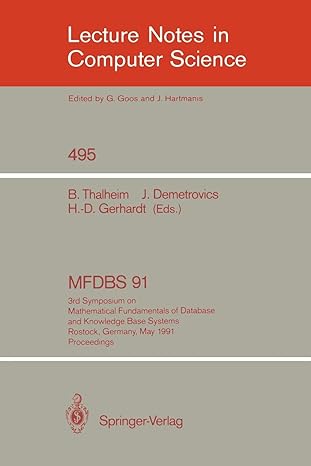Question
Question: Consider the coding and decoding functions E and D defined in Example 7.1.9. (* Include a value E(x) and D(x) that indicates an error.)
Question: Consider the coding and decoding functions E and D defined in Example 7.1.9. (* Include a value E(x) and D(x) that indicates an error.)
a. Find E(0110) and D(111111000111).
b. Find E(1010) and D(000000111111)
Example 7.1.9
Digital messages consist of finite sequences of 0s and 1s. When they are communicated across a transmission channel, they are frequently coded in special ways to reduce the possibility that they will be garbled by interfering noise in the transmission lines. For example, suppose a message consists of a sequence of 0s and 1s. A simple way to encode the message is to write each bit three times. Thus the message
00101111
would be encoded as
000000111000111111111111.
The receiver of the message decodes it by replacing each section of three identical bits by the one bit to which all three are equal.
Let A be the set of all strings of 0s and 1s, and let T be the set of all strings of 0s and 1s that consist of consecutive triples of identical bits. The encoding and decoding processes described above are actually functions from A to T and from T to A. The encoding function E is the function from A to T defined as follows: For each string s A,
E(s) = the string obtained from s by replacing each bit of s by the same bit written three times.
The decoding function D is defined as follows: For each string t T ,
D(t) = the string obtained from t by replacing each consecutive triple of three identical bits of t by a single copy of that bit.
The advantage of this particular coding scheme is that it makes it possible to do a certain amount of error correction when interference in the transmission channels has introduced errors into the stream of bits. If the receiver of the coded message observes that one of the sections of three consecutive bits that should be identical does not consist of identical bits, then one bit differs from the other two. In this case, if errors are rare, it is likely that the single bit that is different is the one in error, and this bit is changed to agree with the other two before decoding
Step by Step Solution
There are 3 Steps involved in it
Step: 1

Get Instant Access to Expert-Tailored Solutions
See step-by-step solutions with expert insights and AI powered tools for academic success
Step: 2

Step: 3

Ace Your Homework with AI
Get the answers you need in no time with our AI-driven, step-by-step assistance
Get Started


